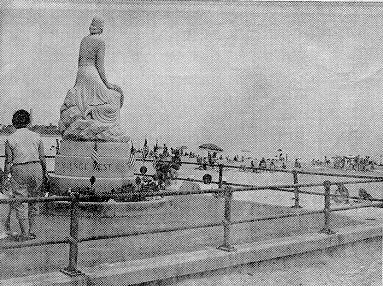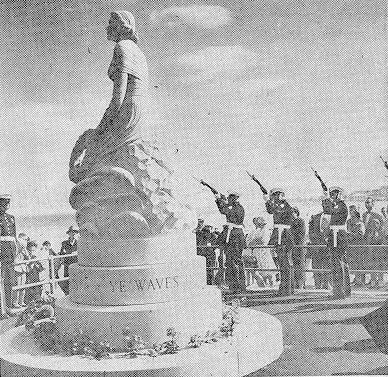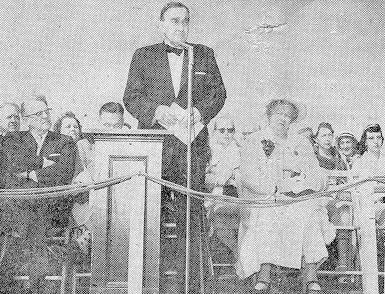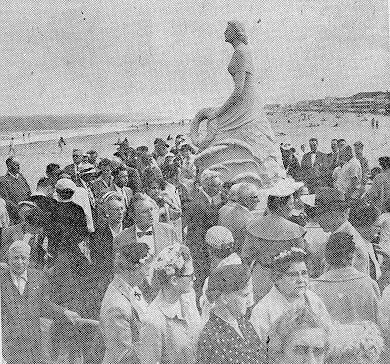Only One In U. S.
Reprint from Manchester Union Leader,
Courtesy of Profile Printing, Manchester, NH
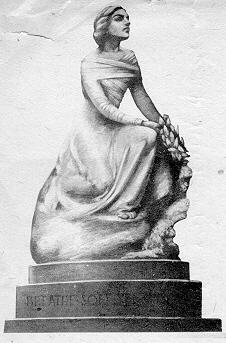
CONCORD, N.H. — A beautiful memorial, depicting a Gold Star mother reverently laying a wreath upon the waves of the Atlantic ocean, will be erected on a ledge on the sea-wall of Hampton Beach in memory of the men and women of all wars who lost their lives at sea in defense of their country.
The memorial is the project of the New Hampshire Marine Memorial Commission, which was reorganized recently with former Concord Mayor Shelby O. Walker as chairman.
At a meeting held here earlier this week, the commission voted to accept the bid of Joseph Comollli, New Hampshire granite contractor, to build the memorial at a cost of $25,000.
Use N.H. Granite
The material to be used in the memorial will be New Hampshire granite from the quarries of the John Swenson Granite company of Concord.
Alice Cosgrove, well-known New Hampshire artist and originator of “Chippa Granite”, designed the drawing for the memorial.
The memorial will constitute the statue proper, mounted on circular bases. Overall size of the bottom base will be five feet six inches. The base, together with the figure of the seated woman, will be 12 feet high. The statue itself will be eight feet in height. The semi-circular seat will be 20 feet long and four feet high, upon which will be carved the names of the New Hampshire men and women lost at sea.
Carved on the base will be the words, “Breathe soft, Ye winds, Ye waves in silence rest.” In the words of the contractor, the mother is represented “looking across the waters, asking that the winds and waves be gentle, as a mother who covers her sleeping child at night.”
In addition to Mr. Walker, other member of the Commission include William E. Downs of Manchester, the original chairman, Reginald Abbott of Candia, Dr. Daniel Poling of Deering, Mrs. Maurice Mullen of Concord, Paul V. Brown of Portsmouth, Mrs. Paul Swanson of New Castle, and Mrs. Robert Goss of Rye.
Harlan L. Goodwin of Portsmsouth is treasurer of the commission, while Peter J. Agrafiotis of Manchester is executive secretary.
Will Be Unique
Mr. Downs is the original chairman of the commission. He has done considerable work on the project, and his research shows that no other state in the Union has built a memorial in honor of the heroes who lost their lives at sea, and whose bodies have never been recovered.
New Hampshire has lost more than 300 of its sons and daughters in this manner to date, according to best estimates available. The memorial will allow space for the carving of approximately 450 names in all.
The $25,000 needed to erect the memorial will be raised in a drive to be started shortly by the Maine Memorial Commission.
The location of the statue will be in front of the Ashworth hotel. The ledge on which the statue will be placed will be 20 feet above the low-elevation point. The highest tide at this particular location goes up to 12 feet.
Cooperating with the Memorial Commission are the state Planning and Development Commission and the state Department of Public Works and Highways.
[The following Letter To The Editors appeared in the Manchester Union Leader, written by William E. Downs, whose idea culminated in the erection of the New Hampshire Marine Memorial at Hampton Beach. Date of letter is unknown at this writing.]
Honored Lost at Sea
Finally Recognized
Addressed to William Loeb: Public Law 85-644,. passed by the 85th Congress, provides families of those lost at sea and missing in action with markers that can be placed on token graves in family burial lots.
THE SERIES OF ARTICLES THAT APPEARED IN YOUR NEWSPAPERS CONDEMNING THE DUMPING AT SEA OFF THE VIRGINIA CAPES OF THE REMAINS OF THE UNKNOWN HERO OF WORLD WAR II DID MUCH TO COMPEL THE PASSAGE OF THIS BILL.
Spotlighting this ceremony of riddance woke up an indignant America which demanded justice and a fair deal for those whose bodies were unrecoverable. It took 17 years after that “dastardly day of infamy” for its accomplishment.
Not until now could the identities of those lost at Pearl Harbor be officially brought home — 1,102 heroes lost on the Arizona whose bodies at battle stations entombed in its battered, rusting hulk will now reap the belated reward for patriotism, along with their 80,000 comrades throughout the world lost at sea.
The American Battle Monuments Commission whose chairman is Gen. George C. Marshall, has yet to consecrate a memorial to identify the unrecovered dead of the Pacific.
With the passage of the enclosed act, August 14, a long overdue debt has finally been paid. Never again shall America’s war dead be forgotten. I would be lax in my gratitude were I not to acknowledge the valued and continued aid rendered by you, your newspapers and their staffs in quest of recognition and remembrance at home for heroes who gave their lives to perpetuate the “Four Freedoms” for all mankind and above all, thought more of their country than they did of themselves.
/s/ WILLIAM E. DOWNS
Manchester.
“IN SILENCE REST” thousands of United States fighting men who died on the water and on other beaches that are like at home, like that at Hampton, might remain free for the use of free Americans. Few pass by the Marine Memorial without pausing to look and probably meditate momentarily on the sacrifices it represents.
[Paul E. Marston Photo]
Joseph Comolli, Concord, General Contractor
Alice Cosgrove, Concord, Artist and Designer
Full-size model made by Caproni Galleries, Inc., Boston, Mass.
Granite from the quarries of the John Swenson Granite Company, Concord
Statue carved by Marr & Gordon, Inc., Barre, Vermont
Monument proper consists of two bases plus the statue.
Bottom base is 6 feet in diameter, total height is 12 feet.
Circular seat 20 feet long, 2 feet 6 inches wide, 4 feet high.
On the second base of the monument, the following inscription is carved:
BREATHE SOFT, YE WINDS * * * YE WAVES IN SILENCE REST
The statue represents those who remember the lives unselfishly dedicated to our country during all wars. Reverently she lays a wreath upon the soft waters which embrace them. As she looks across the waters, she asks that the winds and waves be gentle, as a mother who covers her sleeping child at night.
The rough block of granite which was required to execute this statue, weighed approximately 24 ton. Finished weight of statue approximately 7 ton.
On the back of the seat is carved the following inscription:
“IN MEMORY OF NEW HAMPSHIRE’S HEROIC WAR DEAD
LOST AT SEA IN DEFENSE OF OUR COUNTRY.”
There also is carved 248 names, each name carrying the branch of service to which the deceased belonged. On each end of the seat, the seal of the State of New Hampshire is also carved. Subsequent to 1957, 42 additional names were carved into the seat, which included among others, the Merchant Mariners.
A Marine detail fired a salute during solemn ceremonies of dedication for the N. H. Marine Memorial at Hampton Beach five years ago when the nation’s only memorial of its kind was dedicated. Part of the crowd which attended the ceremonies is shown outside the railing.
HAMPTON BEACH, May 26 — Seventeen years ago the canvas-wrapped body of a young Manchester Army officer slid into the South Pacific — to set off a story of parental devotion which has few equals.
It is the story of how a stubborn, persistent father’s efforts to bring back his boy’s identity led to the N. H. Marine Memorial, still the nation’s only one of its kind.
Many know that the words the statue bears: “Breathe Soft Ye Winds * * * Ye Waves In Silence Rest,” mark the only gravestone for 248 sons of the Granite State.
Yet why these men were selected for the immortality of granite — and some others were no — makes a chapter in New Hampshire history which belongs in print before more years blur why.
Downs’ Vision
The memorial is actually the lengthened shadow of Manchester’s William E. Downs. Without his vision, his never-failing drive, is courage and his old-fashioned determination to get a memorial completed, this Granite Lady — who attracts thousands here each year -— would never have come to be. Nor, of course, would it have without the others who became a living part of the memorial later.
Bill Downs is a man who refused to yield to his government’s rebuffs after he and his wife had, one day in 1945, received a casualty telegram about his son, his only child, from the War Department.
Capt. William D. Downs, a UNH graduate, had fought out World War II in the South Pacific. At long last tapped for rotation to the States, he had boarded a troopship — but his journey ended May 25, 1945 in a vast reach of the ocean, still thousands of miles from home.
Taken Ill
For he had been taken ill aboard ship, and had not lived to see the daughter born after he left for combat.
His loss left his father peculiarly unsettled, with no place to take his grief but the seashore. Though literally thousands of other people played a part, it was Bill Downs’ unremitting personal campaign which lighted the way to “A Place to Remember” — for him and so many others in the same situation — almost 12 years to the day the burial service was read over his son.
On Decoration Day, 1957, this granite memorial was dedicated and presented to the state, to those men of the U. S. armed forces who died or were buried at sea in wartime. These specifics are important.
Dr. Poling Speaks
Dr. Daniel A. Poling, father of one of the “Four Chaplains,” delivered the main address during dedication ceremonies of the N. H. Marine Memorial five years ago next Wednesday. The famed clergyman is shown during that portion of the event. Seated in front are then-Gov. Lane Dwinell, and Mrs. Maurice Mullen of Concord, a member of the Commission which erected the memorial. Artist Alice Cosgrove, who designed the memorial and carved the model from which it was sculptured, is shown second from right, rear.
Dr. Daniel A. Poling of Deering, father of one of these honored men, delivered the main address. On the platform that day were U. S. Sen. Styles Bridges, and Publisher William Loeb of the N. H. Sunday News and Manchester Union Leader — who had earned their places through years of labor to help the project — Bill Downs himself and many others, including the artist-designer Alice Cosgrove, whose combined work made the gift possible.
The audience held fathers, mothers and children of many of those memorialized. Here for the first time, were also presented new University of New Hampshire-developed geraniums, placed around the statue base, and aptly named “Purple Heart.”
The Names
Let’s walk around the memorial today, and read the names of the men it honors.
My wife and I have just dug again into the history — and the memories — of these men. Five years before, we had served as the N. H. Marine Memorial Commission’s name committee deeply concerned with their eligibility.
As a result of our new research, we give you here the first over-all report on those who appear on the memorial. And of some of those who do not. And why.
This memorial was not erected for those who swim or sun- bathe nearby, or wipe towels over damp feet as they sit on the granite seat.
Yet somehow it IS for them, too. If it reminds them of the cost of war.
No Resting Place
For these men disappeared in tearing blasts of shells against ships, in the bloody waters off Tarawa and Iwo Jima, in the crushing weight of depth bombs in their submarines, in the awful impact of their planes, shot out of bright Far East skies, or in the sudden splash of weighted bodies, at conclusion of sea burials.
This memorial gives concrete identity to those New Hampshire men of the armed services who had no final resting place. The 248 identities thus brought back to American shores were the vanguard of the 65,000 other Americans similarly lost where Bill Downs had hoped would be similarly “returned” home.
It helps, as one mother wrote “. . . to quiet that sad restlessness and yearning we have, to know just where they are resting . . .”
Local Boys
There was, for example, smiling Joe Rozmus, remembered who we remembered from his basketball days, who died at Pearl Harbor . . . there was Francis Lally, a Manchester West Side boy who, in a later day, had talked with us about the early shooting war — and had then returned to it, to die in the burning blast and sinking of the escort carrier Liscombe Bay in the Pacific.
And there was Ben Bronstein, a young doctor with whom we sat on a dressing bench at the YMCA and talked about the war. A few short weeks later a U-boat’s torpedoes ripped his destroyer, the Jacob Jones, off the Jersey coast that first February of War II.
Other members of the commission knew men of their own flesh and blood here. “Doctor Dan” Poling’s son’s story follows a little later . . . There was Mrs. Paul S. Slawson of New Castle whose Annapolis-trained husband, Commander Slawson, was lost when his group of LST’s was attacked in the Solomon Sea off Rendova, July 18, 1943. There was Mrs. Robert B. Goss of Rye, whose husband’s cousin, Richard P. Goss, died with his submarine in the Pacific, Dec. 9, 1943.
Grave Known
And there was Mrs. Maurice Mullen of East Concord, whose son Robert was killed in action leading his men in North Africa. Though his grave was known, the Mullens devoted substantial assistance to this memorial project because their own grief made them understand the unsettling loss of these other parents.
Four other New Hampshire-men were entombed in the Pearl Harbor attack. (Others were killed, but their bodies were found.) The first N. H. officer to die, Ensign Edward B. Cloues of Warner was among them, as were Bruce R. Edmunds of Epsom, David L. Crossett of Manchester and Edwin C. Hopkins of Keene.
Our research went right back to the Revolution, to Privateer Stephen Goffe of Bedford. His name finally did not appear because the state officially informed the commission that Goffe was not in the armed services, but was aboard a private ship hunting booty from the enemy.
There are the names of two men -— Fred Blomberg and George Lamiette — who died in the blowing up of the USS Maine in Havana Harbor in ’98, which set off another ~var in another day.
Five New Hampshire men died or were lost when their ships were attacked en route to War I in France. The War II list began even before Pearl Harbor, when the destroyer Reuben James, sunk by a U- boat, took John J. Fitzgerald Jr., of Hampstead to his death.
The list got its only Medal of Honor winner from the Southwest Pacific, when Capt. Harl Pease Jr.—— whose name now graces the giant Portsmouth Air Force base [now Pease International Tradeport in the year 2000] — stubbornly led a key raid on Rabaul August 6-7, 1942. With a combat crew which gallantly volunteered to join him in a “Flying Fortress” known to be crippled, Pease’s ship staggered to the target and dropped its bombs. It was attacked by enemy fighters before it could make cloud cover, and its companions never saw it again. It is believed to have been shot down in flames.
Four Chaplains
You remember the “Four Chaplains”? Three men on the troopship Dorchester were from New Hampshire as she cruised the Davis Strait approach to the Greenland coast on Feb. 3, 1943. Only two of those names are on the list.
One was Chaplain Clark Vandersall Poling, whose love of home meant his favorite Wolfe hill in Deering and his parents’ “Long House” in that high community.
The other was Harold C. Paczosa of Manchester, one of 750 GIs being ferried through the cold mists for Arctic duty.
* Richard Raymond, a Hampton boy, was also aboard and also died in the freezing waters. But his name does not appear, because he was of the Merchant Marine.
Ruled Out
Not one of the members of the Marine Memorial Commission but would have given him a place on the honor roll, but the rules did not include the Merchant Marine in the armed services.
Five other Merchant Marine names in fact, were offered the commission, but also do not appear.
[Footnote: Subsequent to May 30, 1957, 42 names were added to the Honor Roll, including Richard Raymond’s name, and the other Merchant Mariners.]
Hampshire-men who are honored by the N.H. Marine
Memorial, is shown in this picture made just after
conclusion of the dedication ceremony in 1957.
Our count showed that at least five Granite State men died at sea when Japanese suicide strikers beat at, but could not sink, the carrier Franklin one awful day –March 19, 1945 -— off their homeland coast. Eleven N. H. men were lost in all from this battling ship in many actions. The five lost in the spring day of ’45 include:
Henry Bartlett of Goffstown, Clifford Beane of Bennington, Edmond E. Breton of Dover, Myrle Leonard of Springfield, and Clifford V. Nelson of Winchester.
Lost On Subs
Ten other men were lost with their submarines. Others died as their ships crossed apparently friendly waters. One man tossed his cap into the air at his Annapolis graduation in June, and went to the bottom a short five months later in the Pacific.
Another was being ferried across the English Channel to help relieve badly pressed Americans fighting the Battle of the Bulge. Four men were killed from the carrier Quincy, two from the old “Lex.”
But all these were memories when Bill Downs learned that his government would not give him a grave marker for a son whose body was now of the sea. He had asked for one for the family lot In Manchester because he wanted a place to go with his grief.
The government had decided that these men would be memorialized in the Far East and the South Pacific and in Hawaii and Europe. Near where they died.
Not Practical
But for Downs It would have been a 20,000-mile round trip to reach and return from the memorial in the Philippines where young Bill’s name was to go. This was not practical.
So the elder Downs kept trying to win federal attention. He took his problem to Senator Bridges, who used his powerful impact, not once but several times, to persuade the Congress to approve token grave markers. Without success — then.
(Since then, however, Congress has provided for such markers in HR 4381, passed and signed by President Eisenhower Aug. 14, 1958.)
There came a day when Bill laid his campaign before the publisher of the state’s largest newspaper, William Loeb. Here he met sympathy. For Bill Loeb has a fondness for the underdog, and gave him the papers’ powerful news and editorial backing.
First Commission
Happens the project came my way for reportorial attention for the MANCHESTER UNION LEADER, for which I was then writing. The then- governor, Sherman Adams, rose to the challenge and created the first Marine Memorial Commission, with Downs as chairman.
The late General Frank Merrill -— whose “Merrill’s Marauders” had flushed Japs out of the Burma jungles — assigned his Highway Department to prepare the site.
The first favored location was Pulpit Rock In Rye. A landscaping plan was drawn for it, and hopes were aimed to raise enough money for a bronze figure. But ideas changed. Money was hard to find. A proposal to carve the kneeling figure in granite, and place it atop a natural outcropping of ledges at Hampton was settled on.
Special Appeal
There are those who still believe it would have been better to erect the lady in Rye. But many others see great value in a rubbing-elbow neighborliness which is the site’s special appeal now.
Bill was succeeded as chairman by Manchester’s grand old printer, Edward T. McShane, who added his bit to the fund. The third commission, again with Downs as a member, was headed by another persistent driver,. Concord’s late insurance man-mayor-legislator, Shelby “S.O.” Walker, who got the job finished.
Creates Design
This is how a Vermont artisan, Vincenzo Andreani, carved the
N. H. Marine Memorial, using the original clay model in
background. Picture was taken at the Marr and Gordon
granite works in Barre, Vt., while the 24-ton block
of N.H. granite was worked over.
One of the state’s most talented artists, Concord’s Alice Cosgrove, created the memorial design, including the circular base for flowers and the semi- circular seat.
Her design was accepted unanimously after the commission had viewed others, all attempting to symbolize remembrance of a loved one lost at sea. Alice also made a scale model, which was used by a Cambridge, Mass., sculptor; Teodors Uzarins, to model the heroic-size lady in clay at the Caproni Galleries in Boston.
There were other hands in the project. Besides those already named, there were two Portsmouth men, Paul V. Brown and the treasurer, Harlan L. Goodwin. Peter Agrafiotis, a Manchester public relations man, bore the detailed burden of raising the balance of the $30,000 cost once “S. 0.” [Walker] had taken the reins.
With them as leaders, the job was completed by the gifts of many, many donors through local fund chairmen all over New Hampshire -— plus a $ 10,000 matching boost from the 1955 Legislature.
And there was Joseph Comolli of Concord, a granite contractor, who worked far beyond what was required of him until his crane could lower the completed statue on its base just before dedication day.
The 24-ton granite block from which the statue was carved was cut at Swenson’s granite quarries in Concord. Shipped to Barre, Vt., for shaping, it made the trip to Hampton after 17 of those tons had been skillfully removed by an Italian artisan, Vincenzo Andreani of the Marr and Gordon, Inc., granite works.
12 Feet High
From its six-foot base, the statue rises to a height of 12 feet. The circular seat behind it is 20 feet long, two feet, six inches wide and four feet high. It bears 10 columns of names, with the state seal at each end. And the inscription:
In Memory of New Hampshire’s Heroic War Dead Lost at Sea In Defense of Our Country.”
As the oft-quoted phrase “Breathe Soft (selected by Alice Cosgrove from a poem by John Gay, “An Epistle to a Lady,” written in 1714) indicates, the statue represents those who remember the lives unselfishly dedicated to our country during all wars. As Alice wrote, sensitively:
“Reverently she lays a wreath upon the soft waters which embrace them. As she looks across the waters, she asks that the winds and waves be gentle, as a mother who covers her sleeping child at night.”
Highlights Pertaining To New Hampshire Marine Memorial
Erected at Hampton Beach, New Hampshire On May 30, 1957
Information supplied by Joseph Comolli, General Contractor
Joseph Comolli, Concord, General Contractor
Alice Cosgrove, Concord, Artist and Designer
Full-size model made by Caproni Galleries, Inc., Boston, Mass.
Granite from the quarries of the John Swenson Granite Company, Concord
Statue carved by Marr & Gordon, Inc., Barre, Vermont
Monument proper consists of two bases plus the statue.
Bottom base is 6 feet in diameter, total height is 12 feet.
Circular seat 20 feet long, 2 feet 6 inches wide, 4 feet high.
On the second base of the monument, the following inscription is carved:
BREATHE SOFT, YE WINDS * * * YE WAVES IN SILENCE REST
The statue represents those who remember the lives unselfishly dedicated to our country during all wars. Reverently she lays a wreath upon the soft waters which embrace them. As she looks across the waters, she asks that the winds and waves be gentle, as a mother who covers her sleeping child at night.
The rough block of granite which was required to execute this statue, weighed approximately 24 ton. Finished weight of statue approximately 7 ton.
On the back of the seat is carved the following inscription:
“IN MEMORY OF NEW HAMPSHIRE’S HEROIC WAR DEAD
LOST AT SEA IN DEFENSE OF OUR COUNTRY.”
There also is carved 248 names, each name carrying the branch of service to which the deceased belonged. On each end of the seat, the seal of the State of New Hampshire is also carved. Subsequent to 1957, 42 additional names were carved into the seat, which included among others, the Merchant Mariners *[Richard Raymond, USMM, name now is listed on the Roll of Honor].
